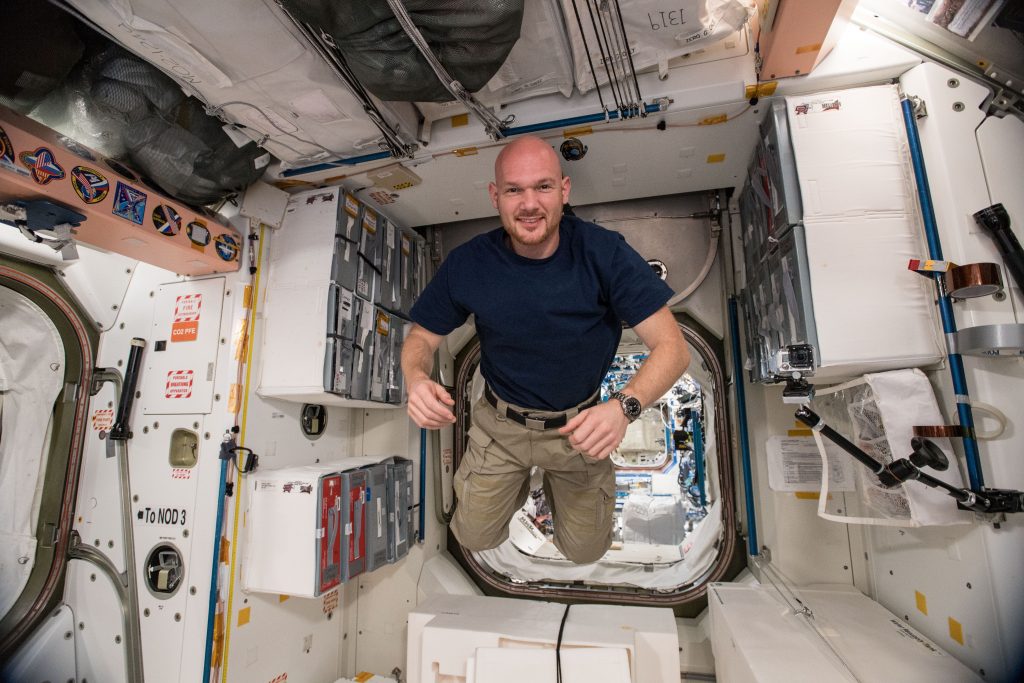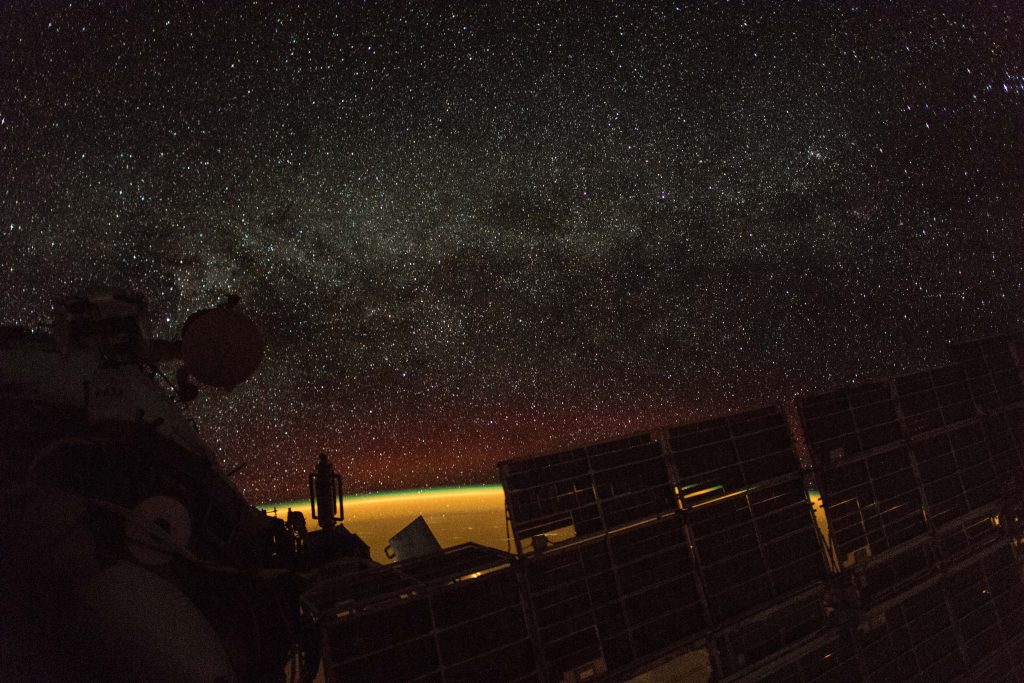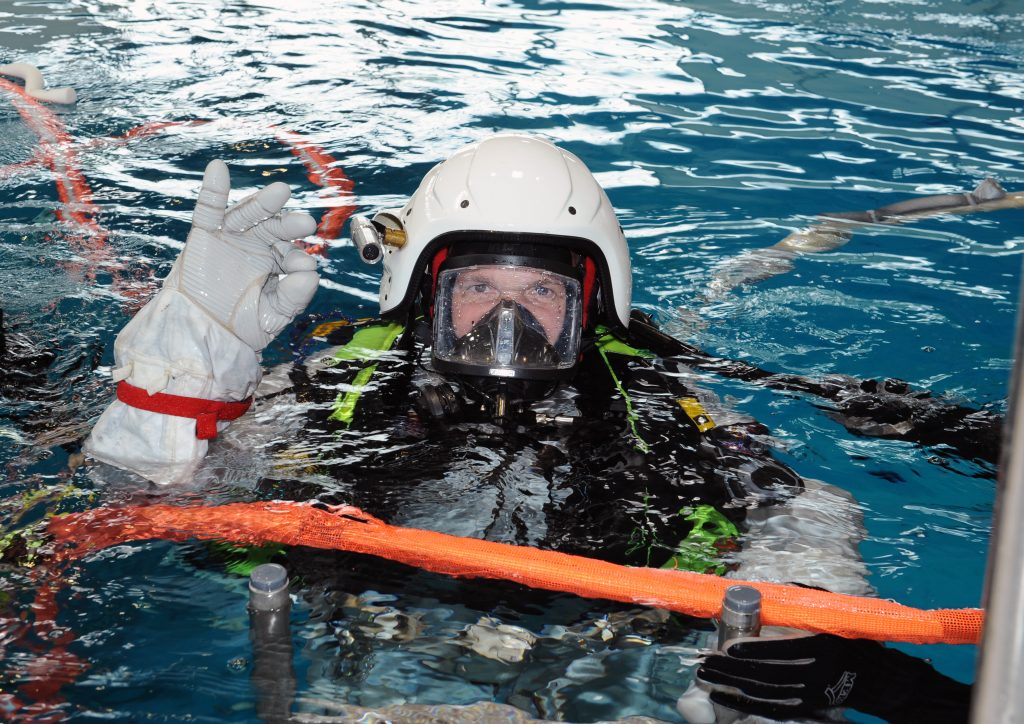This week we celebrate 20 years since the first International Space Station module Zarya was launched into space on 20 November, 1998. To mark the occasion, we are answering 20 of your most frequently asked questions about Alexander Gerst’s time on board the orbital outpost. Read on to be enlightened…
1. How long does it take to get to the International Space Station?
Travelling from the launch site in Baikonur, Kazakhstan to the International Space Station can take anywhere from 6 to 48 hours depending on launch procedures and the Station’s position in orbit.
ESA astronaut Alexander Gerst launched into space alongside NASA astronaut Serena Auñón-Chancellor and Roscosmos commander Sergei Prokopyev on board the Soyuz MS-09 spacecraft at 11:12 GMT (13:12 CEST) on Wednesday 6 June, 2018. After 2 days and 34 orbits of Earth, the trio arrived safely at the International Space Station as planned on 8 June at 13:01 GMT (15:01 CEST).
Watch the full launch from liftoff to orbit below.
2. How high and at what speed does the International Space Station travel?
The International Space Station circles Earth once every 90 minutes. It travels at a speed of around 28 800 km/h and an altitude of 400 km above Earth. Use this map to see where the Space Station is, along with its exact speed and altitude.
3. Can I see the Space Station from Earth and how?
Yes! In fact, many of you already have. As the third brightest object in the sky, the International Space Station looks a lot like a plane – only travelling much higher and much, much faster.
NASA site Spot the Station provides important information on sighting opportunities in your local time zone, including: the maximum time period during which the Station will be visible, its height from the horizon in the night sky, the location in the sky where it will be visible first and the point at which it will disappear.
You can also use an app like ISS Spotter (download here for iOS) or check out this tracker on the ESA website.
4. Is there gravity in space?
Short answer: yes. Gravity, or rather microgravity, is everywhere in space. It is what keeps the Moon in orbit around Earth and Earth in orbit around the sun. So why doesn’t the Space Station fall back to Earth and why do astronauts appear to be floating in space? That’s all to do with speed.
In truth, astronauts are not floating, they’re ‘falling’. But because of the high speed of the Space Station’s orbit, they fall ‘around’ Earth – matching the way Earth’s surface curves. The moon stays in orbit around Earth for this same reason. Since astronauts have the same acceleration as the Space Station, they appear and feel weightless.
5. What does it feel like to float in space?
In his first blog post from the Horizons mission Alexander said: “When the hatch opened to the station, it felt like coming home to me. I immediately got along as well with floating as a fish does with water. Interestingly, my feet and hands have even unconsciously remembered where handrails and foot loops are, and usually, when I flew around a corner, they grasped the correct handrail on their own. But there was one time it didn’t work out so well. My body thought it knew exactly where a handle had to be and reached out to grab it – only to find someone had moved it since my last mission…”
In this earlier interview about his Blue Dot mission, Alexander said that in the beginning life on board the Space Station was a lot like jumping from a 10-metre-high diving board. While he didn’t get sick, he did experience a tingling in his stomach for the first two hours and it felt like he was hanging from the ceiling like a bat.
After two days, his body adapted to the point where it all just seemed normal.

ESA Astronaut Alexander Gerst on board the International Space Station. Credit: ESA/NASA.
6. What is the temperature on the Space Station?
The temperature inside the International Space Station is kept constant at around 22°C.
7. What time is it on the Space Station?
The International Space Station uses UTC or Universal Coordinated Time. This is also referred to as GMT or Greenwich Mean Time and is one hour behind CET (Central European Time).
UTC was selected as the time zone for the Station as it is around the mid-point for all International Space Station partners and allows the two main mission control centres (Moscow and Houston) to cover half a day-shift each.
8. What kind of watches do astronauts wear?
ESA astronauts wear an Omega Speedmaster X33 Skywalker – a new version of the historic space watch, tested and qualified with ESA’s help.
The design of this watch draws on the inventions of ESA astronaut Jean-François Clervoy, who flew to space three times in the 1990s. You can read more about this watch’s development here.
Note: ESA is an intergovernmental organisation and is not involved in the manufacturing or commercialisation of the Omega Skywalker X-33.
9. What food do you eat in space?
According to Alexander, food on board the International Space Station “tastes better than it looks”. That’s just as well as it needs to sustain astronauts through a busy schedule of science and operations.
Most food comes in cans or packets. Some is dried, and astronauts add water to this to make it edible. Other (irradiated) food comes in pouches that astronauts place in an electrical food heater to warm up.
This post on the tastes of space explains more about the crumb-free, light-weight and preservative-free criteria space food must adhere to. You may have also seen Alexander’s posts about growing salad in space. This kind of activity will be essential for longer term deep space missions.
Hello world! Update on our salad project for a healthier thanksgiving meal. / Hallo wach! Unser Thanksgiving Salatprojekt ist auf dem richtigen Weg. Mmmmh… #horizons pic.twitter.com/6Btd6eP6yM
— Alexander Gerst (@Astro_Alex) November 4, 2018
https://platform.twitter.com/widgets.js
10. How do astronauts wash their clothes in space?
There is no washing machine on the International Space Station so astronauts must wear their clothes for several days before changing them. Luckily, in the Space Station environment these don’t get as dirty as they might do on Earth and some items such as socks and exercise gear contain anti-bacterial materials to help pro-long their wear.
Exercise gear is changed weekly, underwear is changed every few days, while shirts and pants can be worn for weeks.
In case you were wondering how many fresh clothes an astronaut on the International @Space_Station gets to wear every two weeks (yep, that’s five sets of underwear). #Horizons pic.twitter.com/ptSrfDoS32
— Alexander Gerst (@Astro_Alex) November 3, 2018
https://platform.twitter.com/widgets.js
11. What is an astronaut’s daily routine?
An average day in the life of an astronaut on the International Space Station looks a little bit like the below:
- 6:30: Wake up and start the day with the space version of a shower using wet cloths and dry shampoo. Brush teeth with edible toothpaste.
- 7:00: Eat breakfast. Alone or with other crew mates. There is coffee and tea, but instead of bread or bread rolls (that might crumble) astronauts instead choose tortillas or other space-suitable breakfast options.
- 7:30: Daily conference with ground control to review the day’s tasks and answer any questions. One after the other the astronauts are connected with relevant ground control stations in the US, Russia, Europe and Japan. This takes 15 to 30 minutes.
- 7:45: Start of actual working day. Astronauts spend the majority of their time working on scientific experiments according to that day’s schedule.
- Between 12:00 and 14:00: Hour-long lunch break. Alone or with other crew members.
- After lunch: More scientific experiments, exercise and other scheduled tasks.
- Between 19:00 and 19:30: Evening conference. Every ground station takes part in this. The astronauts report on the experiments they conducted and any issues they may have had. This evening catch-up is usually very quick.
- 19:30: End of work day. Now astronauts can write emails, read, listen to music, watch movies or take photos of Earth from the Cupola window.
- 20:00: Dinner with International Space Station crew
- 22:15: Bed time. Every astronaut decides when to go to bed. While sleeping, astronauts wear earplugs because it is relatively loud on Station.
12. What camera equipment does Alexander use?
Alexander takes some fantastic photos both inside the International Space Station and of Earth below. In fact, imagery captured on board the Station has progressed from 35mm film and SD 4×3 video to 20.8 MP digital stills and 8K video in the 20 years of Space Station operation.
Most of Alexander’s current shots are taken with a Nikon D5 (DSLR). He also recently shot footage for the first ever 8K video from space using a RED Helium camera. This is available to view on YouTube. There are also numerous other cameras positioned around the Space Station to capture imagery on board.
13. Where can I get pictures from the International Space Station in original quality?
All images posted to Alexander’s social media channels throughout the Horizons mission are also available to view and download in high resolution on Flickr. If you choose to share these, please ensure you use the appropriate credits.
More can be found on the European Space Agency Flickr channel and ESA’s Space in Images.
14. Can you see stars and planets and do they look different?
Stars and planets are visible from the International Space Station. In fact, Alexander has taken some stunning images of the Moon, Mars and the Milky Way during his missions.

Milky Way as seen from the International Space Station. ESA/A.Gerst.
From the perspective of the Station, stars appear to be clearer and twinkle less than on Earth. This is because the Station is positioned outside the atmosphere that causes twinkling and starlight doesn’t have to travel through the same amount of gas and dust. The higher you are, the less of this atmosphere that starlight has to travel through.
Planets also appear much brighter in space – particularly Jupiter, Venus and Mars.
15. What happens during landing?
Astronauts return to Earth in the same vehicle they used to travel to the International Space Station. In the case of Alexander Gerst and his crew, this is the Soyuz MS-09.
The Soyuz descent module must reenter Earth’s atmosphere at a specific angle to adequately reduce its speed. If the angle is too flat, the capsule could bounce back into space like a stone skipping across water. If the angle is too steep, the capsule could get too hot.
The Soyuz’s descent module has a heat shield that protects astronauts up to 1600C and astronauts experience a maximum gravitational load of 4 g when the capsule reaches an altitude of 35 km.
In the unlikely event that the automatic control system fails, the crew use a manual controller as backup. They train extensively to prepare for this possibility. Another option is the ballistic descent in which the spacecraft starts spinning and flies a much steeper trajectory. The g load in this case will increase up to nine.
When the capsule reaches an altitude of 10.5 km its speed has already decreased from 28 000 to 800 km/h. in order to decrease this speed even further, a series of parachutes are deployed. At a height of 8.5 km, the drogue shoot deploys the main parachute which slows the capsule down to 22 km/h.
Right before the capsule reaches the ground, soft lander thrusters fire. This further reduces its speed to approximately 5 km/h. Custom seats help absorb the shock of impact, but there really is no such thing as a soft landing in a Soyuz.
The video below provides a more detailed explanation of the Soyuz undocking, reentry and landing process. It is a great resource for understanding exactly how the return to Earth plays out.
16. Is it possible to build a space station that has artificial gravity?
In theory, this would be possible. Rotational simulated gravity has been proposed as a solution to the prolonged health effects of human spaceflight (perhaps most famously in 2001: A Space Odyssey). However, the size and cost of producing this kind of spacecraft would be enormous. It would also negate one of the most important aspects of the International Space Station – the ability for researchers to conduct scientific experiments in microgravity.
17. Why is research on the International Space Station important?
The International Space Station is the only laboratory we have that allows researchers to perform long-term experimentation in microgravity. It allows astronauts to run investigations that are not possible anywhere else, and the information we gather through this has many benefits back on Earth.
European experiments on the International Space Station include research into the impact of gravity on muscle tone and time perception. The outcomes of time research could benefit the elderly, incapacitated or those working in isolation, while research into muscle tone could benefit patients going through long periods of inactivity. Other experiments aim to build a better understanding of materials and their behaviours, interactions between atoms, and even artificial intelligence and robotics. All of this knowledge will be applied to the benefit of Earth.
18. What happens if someone on Station gets sick?
Astronauts are subject to two weeks of quarantine before flying to space and many precautions are taken to ensure the Space Station remains as hygienic as possible. All astronauts also receive 2-3 weeks of medical training in which they learn different skills such as how to pull a tooth, repair a filling or perform a cardiac massage.

Practising cardiac massage in space. ESA/NASA.
Thankfully it has never happened before, but if any major medical intervention such as surgery is required there is a rescue capsule docked to the Station ready to go at any moment. This is the vehicle in which the crew arrived.
The decision to return to Earth would not be made lightly as it would put an end to the crew’s mission, but this decision is not made by the astronauts alone. The International Space Station crew is supported at all times by an expert medical team on the ground.
19. What did Alexander Gerst study?
Alexander Gerst is a geophysicist and volcanologist by training. In 2003, he received a diploma in geophysics from the University of Karlsruhe, Germany, and a master’s degree in Earth sciences from the Victoria University of Wellington, New Zealand. Both degrees were awarded with distinction.
In 2010 he graduated with a Doctorate in Natural Sciences from the Institute of Geophysics of the University of Hamburg, Germany. His dissertation was on geophysics and volcanic eruption dynamics.
20. How can I become an astronaut?
Becoming an astronaut is neither simple nor straightforward as there are no schools for astronauts or university courses. So how do you become an astronaut and what qualifications and qualities do you need?
Space agencies look for the best people possible. Training an astronaut is a considerable investment for any agency. Training is lengthy and expensive and the support needed both before and during a space mission is costly.
Astronauts need to be able to apply their considerable knowledge and skills to the tasks for which they have been trained, bear tremendous responsibility while in orbit and be determined to succeed.
A high level of education in scientific or technical disciplines, coupled with an outstanding professional background in research, application or education fields possibly supported by the use of computer systems and applications, is essential. Previous experience with aircraft operations is a bonus, particularly if it involved responsible tasks such as being a test pilot or flight engineer.

Alexander during training at EAC. ESA.
Astronauts must undergo intense periods of training and may participate in spaceflights that last for months. During this time their body is subject to a great deal of stress, making good health and physical endurance essential.
They must also have an affinity for teamwork and adaptability as they’ll need to live with others in a small, closed and remote space. They must also possess a high degree of self-control and an equable temperament to cope with any stress or emergencies that may arise.
ESA is not currently recruiting for astronauts. However, there are many other avenues you can pursue to help progress Europe’s role in space. From psychology and medicine to engineering, technology, science, architecture and communications, the options are almost endless. Working together we can go much further – to the Moon, Mars and beyond!




Discussion: 2 comments
I’m quite excited to read this; DANKE!! The ISS team is in my prayers every day, tho my own access to technology is very limited and so i am not very up-to-date!
I’m also reading some of Dr. Gerst’s volcanology research… i imagine he must miss THAT work ALOT!!
Again, thanks for your dedication… and your love for your fellow human beings! Sincerely, Stacy Brownlee (aka: spacybee )
I like Everything . I know now little be more about Space Station.